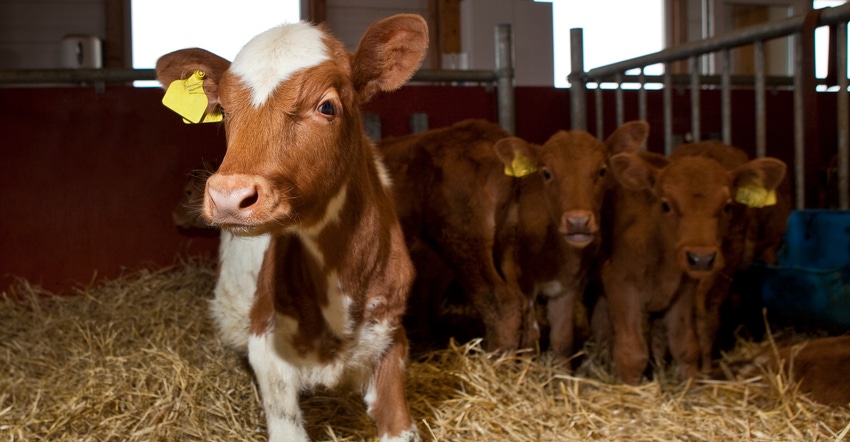Adding calf value begins at working chute
Buckeye Beef Brief: By combining multiple opportunities and management strategies, value can be added to a calf crop.
April 21, 2021

Frequently over the years, we’ve talked about Ohio’s average cow herd size — between 16 and 17 cows at any given time — and how it affects management and marketing decisions for the "average-size" beef farm. Related to that, I’m often asked how farmers of average-size herds can compete economically with those with large cow numbers taking advantage of the economics of scale by selling calves in pot load lots.
When thinking about the numbers it might take to capture the benefits of size and scale, keep in mind most cattle travel to and from the feedlot in pot loads carrying 48,000 pounds. Also, the question of how smaller herds can compete on a scale with larger herds is not unique to Ohio’s cattlemen.
As we look to our neighbors, we find the average cow herd sizes in the surrounding states of Indiana, Michigan, West Virginia and Pennsylvania range from just over 12 cows per farm to almost 19. Kentucky has the most of any neighbors, averaging about 31 cows.
It’s apparent the challenges of competing economically when owning a relatively small cow herd is not just a concern in Ohio. None of our neighbors’ average-size herds have the capacity to ship even a mixed sex, pot load of cattle themselves, much less a load of all steers or all heifers.
Since it appears much of the Midwest may be in essentially the same boat when it comes to average herd size, let’s explore a few alternatives that might allow individuals to better compete in the marketplace. While no single management solution exists, by combining multiple opportunities and management strategies, value can certainly be added to a calf crop.
Add value
Perhaps one of the greatest limiting factors to adding value to individual calves is the ability to handle and process calves in a timely and efficient fashion. Handling facilities allow for easier use of estrus synchronization, pregnancy checking, timely vaccinations, castration, dehorning and even AI.
Combined, these management practices lead to the uniformity that even in small groups can result in better marketing opportunities. Let’s take a brief look at some of those opportunities more closely.
Any time that estrus synchronization is mentioned, thoughts immediately turn to artificial insemination. While the opportunities afforded by individually creating matings to the best bulls in the world through an artificial insemination program are undeniable, it is not something all cattlemen choose to do.
Regardless, perhaps the greatest benefit to estrus synchronization is the ability to maintain a tighter calving season regardless of using artificial insemination or the natural service of a bull. The financial benefits of maintaining a tighter calving season come in multiple forms.
First and foremost, a tighter calving season that gets more calves on the ground earlier results in additional overall weaning weight. Each calf that is born a 21-day cycle earlier likely results in an additional 30 to 50 pounds of marketable calf weight.
The second opportunity a tighter calving season affords is greater numbers of similar weight calves to market in groups. Data shared by University of Kentucky economist Kenny Burdine during last winter’s Ohio Calf Market Outlook meeting showed an $11 per cwt advantage when calves could be marketed in groups of at least five as opposed to singles.
When that group of calves grows to 10 head, the advantage becomes $15 per cwt. As Burdine went on to point out, combining the advantages of the extra weight realized by calving a cycle earlier with the additional value gained when selling in a larger group can easily exceed $100 per calf.
Another opportunity afforded by maintaining adequate cattle-handling facilities is the ability to castrate calves before marketing, thus being able to market steers as opposed to bull calves. During our outlook program last winter, Burdine shared that when summarizing Kentucky feeder calf sale data over the past 11 years, he found 550-pound steers outsold 550-pound bulls by an average of $11.14 per cwt, or more than $61 per head.
Vaccinate
The value of incorporating a vaccination program into the calf weaning and marketing protocol was a topic shared by Ohio Beef field specialist Garth Ruff during another Ohio Beef School program. Ruff pointed out market data showing properly vaccinated feeder calves average $5 to $9 per cwt more value in the marketplace than contemporaries receiving no vaccination protocol.
The opportunity to pregnancy-check cows and the potential cost savings of timely culling the opens are an undeniable benefit of maintaining working facilities. As shared by both Al Gahler and Dean Kreager during our Beef School sessions, we learned the costs of keeping each open cow can easily range from $400 to perhaps $800 per cow held in the herd and not culled. Depending on the method of confirming pregnancy that’s employed, these savings can come at a cost ranging from only $4 to $35 per head.
Frankly, there’s no magic bullet to compensate for the economics of scale that larger cow herds may capture. However, simply maintaining facilities allowing timely individual cow or calf management practices may be the most vital and pivotal component to creating an opportunity to compete with the economics of scale larger herds enjoy. In fact, perhaps greater calf profits don’t begin at the loading chute at all, but rather they begin at the working chute.
Smith is a program assistant in the Fairfield County OSU Extension office and a member of the OSU Extension Beef Team. The Beef Team publishes the weekly Ohio BEEF Cattle letter, which can be received via email or found at beef.osu.edu .
About the Author(s)
You May Also Like


.png?width=300&auto=webp&quality=80&disable=upscale)
